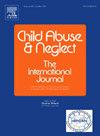Associations between adverse childhood experiences, resilience, and health and educational outcomes using data from the 2022 National Survey of Children's Health
IF 3.4
2区 心理学
Q1 FAMILY STUDIES
引用次数: 0
Abstract
Background
Exposure to adverse childhood experiences (ACEs) is associated with poor childhood health. There is increasing interest in understanding the influence of positive childhood experiences (PCEs) because of their potential protective role against ACEs.
Objective
We sought to understand 1) whether PCEs are protective against developing learning disabilities and mental, emotional, developmental, and behavioral conditions (MEDBC); 2) whether this relationship varies by number of ACEs.
Participants and setting
We analyzed the 2022 National Survey of Children's Health (NSCH).
Methods
We constructed a variable for “high ACEs” (4+), and 6 PCEs were considered. Outcomes were MEDBC and learning disability. Logistic regression models were: 1) using high ACEs and each individual PCE as predictors; and 2) Model 1 + an interaction term for high ACEs x each PCE. Models were nationally weighted using survey-provided sampling weights and controlled for covariates with significance at p < 0.05.
Results
The sample consisted of 53,133 children. In Model 1, each PCE except reading together (p = 0.795) and singing together (p = 0.551) was associated with a significantly lower odds of having MEDBC. Each PCE except reading together (p = 0.259), singing together (p = 0.583), and having meals together (p = 0.726) was associated with a significantly lower odds of having learning disabilities.
Conclusions
Regardless of number of ACEs, PCEs were associated with lower odds of having a MEDBC and a learning disability. As the enthusiasm for ACEs screening continues, clinicians should also consider PCE screening.
利用来自2022年全国儿童健康调查的数据,研究不良童年经历、韧性与健康和教育成果之间的关系
童年不良经历(ace)与儿童健康状况不佳有关。由于积极童年经历(pce)对ace的潜在保护作用,人们对其影响的了解越来越感兴趣。目的:我们试图了解1)pce是否对发展中的学习障碍和精神、情感、发育和行为状况(MEDBC)有保护作用;2)这种关系是否随ace数量的变化而变化。我们分析了2022年全国儿童健康调查(NSCH)。方法构建“高ace”(4+)变量,考虑6个pce。结果为MEDBC和学习障碍。Logistic回归模型:1)以高ace和个体PCE为预测因子;2)模型1 +高ace x每个PCE的相互作用项。模型使用调查提供的抽样权重进行全国加权,并控制协变量在p <的显著性;0.05.结果样本包括53,133名儿童。在模型1中,除一起阅读(p = 0.795)和一起唱歌(p = 0.551)外,每项PCE与MEDBC的发生率显著降低相关。除了一起阅读(p = 0.259)、一起唱歌(p = 0.583)和一起吃饭(p = 0.726)外,所有的PCE都与学习障碍的发生率显著降低有关。结论:无论ace的数量如何,pce与发生MEDBC和学习障碍的几率较低相关。随着对ace筛查的热情持续,临床医生也应该考虑PCE筛查。
本文章由计算机程序翻译,如有差异,请以英文原文为准。
求助全文
约1分钟内获得全文
求助全文
来源期刊

Child Abuse & Neglect
Multiple-
CiteScore
7.40
自引率
10.40%
发文量
397
期刊介绍:
Official Publication of the International Society for Prevention of Child Abuse and Neglect. Child Abuse & Neglect The International Journal, provides an international, multidisciplinary forum on all aspects of child abuse and neglect, with special emphasis on prevention and treatment; the scope extends further to all those aspects of life which either favor or hinder child development. While contributions will primarily be from the fields of psychology, psychiatry, social work, medicine, nursing, law enforcement, legislature, education, and anthropology, the Journal encourages the concerned lay individual and child-oriented advocate organizations to contribute.
 求助内容:
求助内容: 应助结果提醒方式:
应助结果提醒方式:


